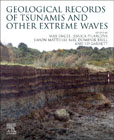
Geological records of tsunamis and other extreme waves
Engel, Max
Pilarczyk, Jessica
May, Simon Matthias
Brill, Dominik
Garrett, Ed
Geological Records of Tsunamis and Other Extreme Waves provides a systematic compendium with concise chapters on the concept and history of palaeotsunami research, sediment types and sediment sources, field methods, sedimentary and geomorphic characteristics, as well as dating and modelling approaches. By contrasting tsunami deposits with those of competing mechanisms in the coastal zone such as storm waves and surges, the book is also relevant to readers interested in palaeo-tempestology and coastal sediment dynamics. The effectiveness of palaeotsunami records in coastal hazard mitigation strategies strongly depends on the appropriate selection of research approaches and methods that are tailored to the site-specific environment and age of the deposits. In addition to summarising the state-of-the-art in tsunami sedimentology, Geological Records of Tsunamis and Other Extreme Waves guides researchers through establishing an appropriate research design and how to develop reliable records of prehistoric events using field-based and laboratory methods, as well as modelling and statistical techniques. Features a comprehensive overview of tsunami sedimentology and palaeotsunami researchIncludes a guide to choosing proxies and analytical approaches for investigating tsunami depositsOffers advice on the most appropriate mapping, sampling, and analytical approaches for a wide variety of coastal settings and sedimentary environments INDICE: Section 1: Introduction Geological records of tsunamis and other extreme-wave events - concepts, applications and a history of research Historical records of tsunamis Instrumental records of tsunamis Tsunami magnitude scales Trigger mechanisms and hydrodynamics of tsunamis (and extreme storms?) Palaeotsunami databases Overview of sediment types and archives Section 2: Field Methods Stratigraphic sampling Subaquatic geophysics Ground penetrating radar Mapping of subaerial coarse clasts Post-tsunami surveys Section 3: Fine-Grained Deposits/Proxies Sedimentology Geometry Foraminifera Ostracoda Diatoms Mollusc shells Anisotropy of magnetic susceptibility MicroCT Geochemistry Microtexture on quartz DNA Aromatic hydrocarbons Postdepositional changes of tsunami deposits and preservation potential Experimental models of fine sediment transport by tsunamis Numerical models of fine sediment transport by tsunamis Section 4: Coarse-Clast Deposits Spatial patterns of subaerial coarse-clasts Reconstruction of transport modes & flow parameters Megatsunami conglomerates Post-depositional weathering of coarse clasts (very short) Experimental models of coarse-clast transport by tsunamis Numerical models of coarse-clast transport by tsunamis Section 5: Erosional Impact Erosional signatures in ridge-and-swale sequences Erosion and re-organisation of beach and barrier coasts after tsunami impact Impact on dunes Impact on rocky coasts Section 6: Dating Radiocarbon: fine deposits Radiocarbon: boulders OSL (both exposure and burial) 210Pb, 137Cs Archaeological dating ESR dating of coarse clasts Palaeomagnetic, Th-U, and surface exposure dating (cosmogenic nuclides) of coarse clasts
- ISBN: 978-0-12-815686-5
- Editorial: Elsevier
- Encuadernacion: Rústica
- Páginas: 800
- Fecha Publicación: 01/01/2020
- Nº Volúmenes: 1
- Idioma: Inglés
